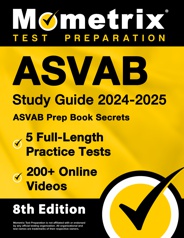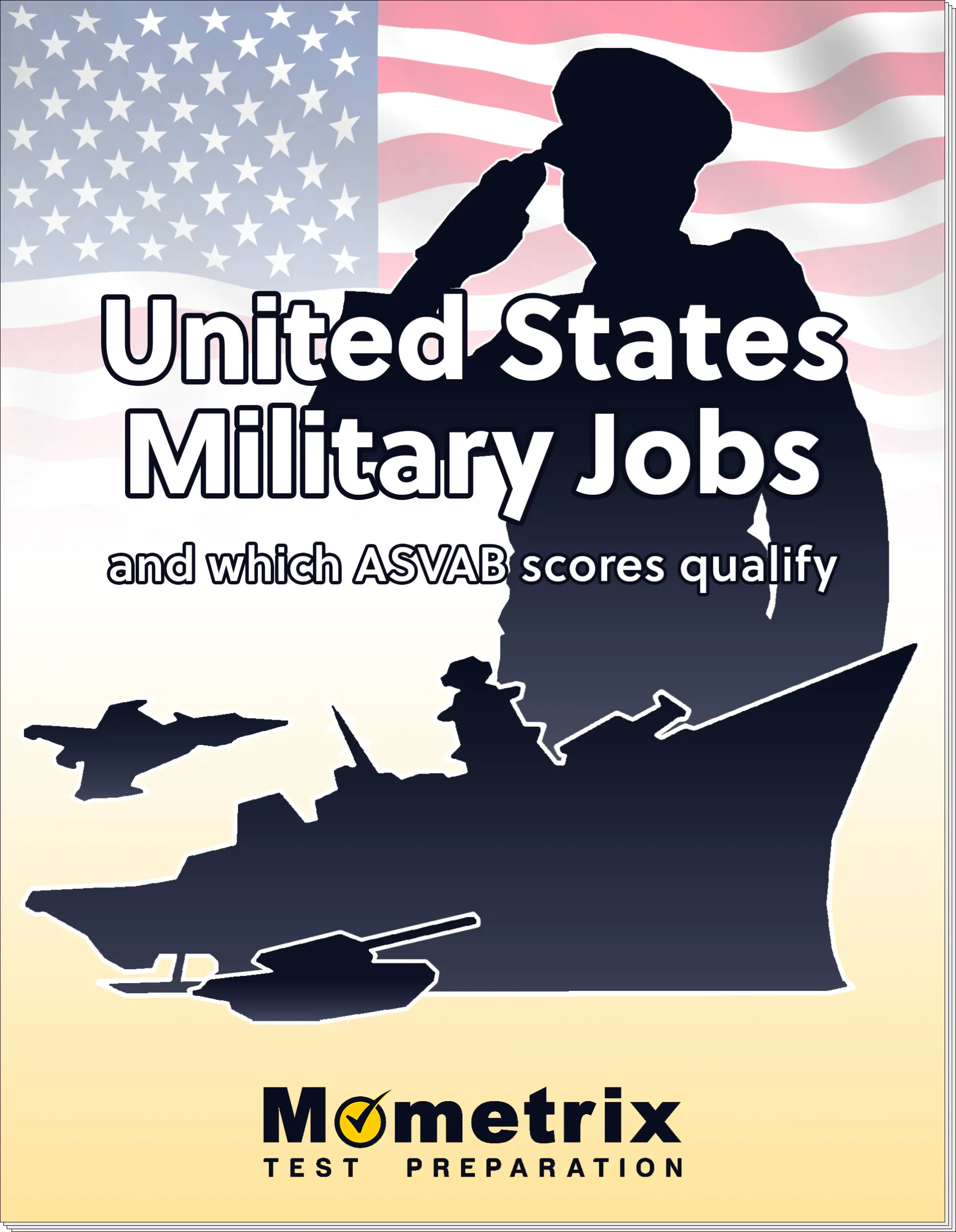The ASVAB test is a multiple-choice test used by the military to measure an applicant’s suitability for enlistment.
It’s important to do well on the test because high ASVAB test scores lead to more and better military career options. Test practice scores are based mostly on the math and verbal sections, so these are the critical areas to study for with multiple ASVAB practice tests.
You can use our large and growing library of free ASVAB practice test questions and videos to help you prepare for this all-important exam:
What is the ASVAB Test?
The military is always looking for people of good character, health, and intelligence to serve the US in the armed forces. To enlist in the military, the first step is to contact a recruiter who will interview you to determine whether they think you are a good candidate for service.
If you make this first cut, you will need to take a physical exam and sit for the ASVAB (Armed Services Vocational Aptitude Battery) test. The testing tells your recruiter whether you have the skills and intelligence needed to perform well in different roles in the military, and a good score helps to give you a head start on your career path.
You should note that the exam is given only in English. This is because all the documents you will need to reference during your military career are in English. Even if English is not your native language, you should be able to make the cut as long as you study enough. You may need to take another test, the ECL (English Comprehension Level), to make sure that you can read and follow instructions given in English if it is not your native language.
What is the CAT-ASVAB?
The computerized administration of the ASVAB is called the Computerized Adaptive Testing (CAT) ASVAB. As it states in the name, this version of the test is adaptive, meaning that the test monitors your responses and adapts the questions to match your abilities. Here’s a look at how it works:
Essentially, if you answer a question correctly, you get a more difficult question, but if you are incorrect, you are given an easier question to answer.
Although there is an overall time limit of 198 minutes, you can complete the CAT-ASVAB at your own pace; when you answer all the questions in one section, you don’t have to wait for everyone else in the room to complete that section. In fact, you are free to leave the test room as soon as you have completed the exam.
It’s important to note that once submitted, you can’t go back to review or change your answers, so be cautious before making final decisions.
Check Out Mometrix's ASVAB Study Guide
Get practice questions, video tutorials, and detailed study lessons
Get Your Study Guide
What is the P&P-ASVAB?
The P&P-ASVAB is the name of the traditional paper-and-pencil test. Unlike the CAT-ASVAB, this version of the test is not adaptive and must be taken at the same pace as everyone else in the testing room. Though you are allowed to review and change your answers before moving on to a new section, you can’t go back to a previous section, and you are not allowed to move on to the next section until given permission to do so by an administrator.
Another important detail of the P&P-ASVAB is that any question that is left unanswered will be counted as incorrect. This means that, if you aren’t sure of an answer and/or are running out of time, making guesses is advantageous.
ASVAB Online Prep Course
If you want to be fully prepared, Mometrix offers an online ASVAB Prep Course. The course is designed to provide you with any and every resource you might want while studying. The ASVAB Course includes:
- 104 Lessons Covering Every Topic
- 1,550+ ASVAB Practice Questions
- Over 240 Video Tutorials
- More than 300 Electronic Flashcards
- Money-back Guarantee
- Free Mobile Access
- and More!
The ASVAB Prep Course is designed to help any learner get everything they need to prepare for their ASVAB exam. Click below to check it out!
ASVAB vs. AFQT – What’s the Difference?
It’s common to think that the ASVAB and the AFQT are two different exams. In reality, the ASVAB is the only exam you will take. The AFQT (Armed Forces Qualification Test) is more of a scoring system that is used to determine a person’s enlistment eligibility. To make this determination, the scores from four sections of the ASVAB are combined:
So, what’s the point of the rest of the ASVAB sections? The AFQT score just determines your eligibility to enlist in the military at all. Once you’ve qualified to enlist by achieving a passing AFQT score, your performance on the ASVAB as a whole can help jump-start your military career by increasing the odds of landing the assignment you want.
Test Sections
There are ten sections on the exam, listed here in order of administration:
All questions on the test are multiple-choice. Each section has a maximum time limit for you to complete the questions in that section. The number of ASVAB test questions in each section and how easy or difficult the questions are may be different depending on whether you are taking the computerized CAT-ASVAB or the pencil and paper P&P-ASVAB.
| CAT-ASVAB | P&P-ASVAB | |||||
| Test | Length | Time Limit | Test | Length | Time Limit | |
| GSGeneral Science | 15 Questions | 12 Minutes | GSGeneral Science | 25 Questions | 11 Minutes | |
| ARArithmetic Reasoning | 15 Questions | 55 Minutes | ARArithmetic Reasoning | 30 Questions | 36 Minutes | |
| WKWord Knowledge | 15 Questions | 9 Minutes | WKWord Knowledge | 35 Questions | 11 Minutes | |
| PCParagraph Comprehension | 10 Questions | 27 Minutes | PCParagraph Comprehension | 15 Questions | 31 Minutes | |
| MKMathematics Knowledge | 15 Questions | 31 Minutes | MKMathematics Knowledge | 25 Questions | 24 Minutes | |
| EIElectronics Information | 15 Questions | 10 Minutes | EIElectronics Information | 20 Questions | 9 Minutes | |
| AIAuto Information | 10 Questions | 7 Minutes | ASAuto and Shop Information | 25 Questions | 11 Minutes | |
| SIShop Information | 10 Questions | 6 Minutes | MCMechanical Comprehension | 25 Questions | 19 Minutes | |
| MCMechanical Comprehension | 15 Questions | 22 Minutes | AOAssembling Objects | 25 Questions | 15 Minutes | |
| AOAssembling Objects | 15 Questions | 18 Minutes | TOTAL: | 225 Questions | 149 Minutes | |
| TOTAL: | 135 Questions | 198 Minutes | ||||
| CAT-ASVAB | ||
| Test | Length | Time Limit |
| GSGeneral Science | 15 Questions | 12 Minutes |
| ARArithmetic Reasoning | 15 Questions | 55 Minutes |
| WKWord Knowledge | 15 Questions | 9 Minutes |
| PCParagraph Comprehension | 10 Questions | 27 Minutes |
| MKMathematics Knowledge | 15 Questions | 31 Minutes |
| EIElectronics Information | 15 Questions | 10 Minutes |
| AIAuto Information | 10 Questions | 7 Minutes |
| SIShop Information | 10 Questions | 6 Minutes |
| MCMechanical Comprehension | 15 Questions | 22 Minutes |
| AOAssembling Objects | 15 Questions | 18 Minutes |
| TOTAL: | 135 Questions | 198 Minutes |
| P&P-ASVAB | ||
| Test | Length | Time Limit |
| GSGeneral Science | 25 Questions | 11 Minutes |
| ARArithmetic Reasoning | 30 Questions | 36 Minutes |
| WKWord Knowledge | 35 Questions | 11 Minutes |
| PCParagraph Comprehension | 15 Questions | 13 Minutes |
| MKMathematics Knowledge | 25 Questions | 24 Minutes |
| EIElectronics Information | 20 Questions | 9 Minutes |
| ASAuto and Shop Information | 25 Questions | 11 Minutes |
| MCMechanical Comprehension | 25 Questions | 19 Minutes |
| AOAssembling Objects | 25 Questions | 15 Minutes |
| TOTAL: | 225 Questions | 149 Minutes |
AFQT-related Sections
Mathematics Knowledge (MK)
The MK section of the test covers basic high school-level mathematics rules, terms, and concepts. The CAT-ASVAB has 15 questions with a 31-minute time limit, while the P&P-ASVAB has 25 questions with a 24-minute time limit to finish the section.
The questions in this part of the test are in the form of math problems. The key to studying for this section is to know your basic math concepts and how they work! You will need to have a good understanding of topics normally covered in high school algebra courses, such as:
- Order of operations
- Exponents
- Simple geometry (circles, triangles, rectangles)
- Fractions, percentages and interest
- Factorials
- Different types of numbers (real numbers, integers, rational numbers, prime numbers, etc.)
Arithmetic Reasoning (AR)
The AR section tests your ability to put your math skills to work by solving some basic word problems. The CAT-ASVAB has 15 questions which you have 55 minutes to answer, while the P&P-ASVAB has 30 questions and gives you 36 minutes to finish the section.
If you know how to approach the questions in this section, you should have no trouble at all. It’s well worth your time to take our practice tests, using the same logical steps to solve each problem until they become second nature. To solve these word problems, you will need to:
- Identify the question you are being asked.
- Rewrite that question as a mathematical equation.
- List the information you will need to know to solve the problem.
- List each step you must take to solve the problem.
With enough practice, you will automatically follow these steps and easily answer the word problems in this section.
Check Out Mometrix's ASVAB Flashcards
Get complex subjects broken down into easily understandable concepts
Get Your Flashcards
Paragraph Comprehension (PC)
The PC section tests your ability to understand written information and identify key points within a paragraph of text. The CAT-ASVAB has 10 questions and gives you 27 minutes to answer them, while the P&P-ASVAB has 15 questions that you have 13 minutes to finish.
Don’t let the PC section of the test throw you for a loop. Unlike the individual multiple-choice questions in other sections, here you will need to read a paragraph and answer several questions in a row based on that one paragraph. The people who designed this section of the exam really knew how to make sure you are able to read detailed (and often boring) documents, remember the details of what you read, understand why they’re important, and be able to pick out the key concepts they illustrate.
When you read each paragraph, it’s helpful to know the kinds of questions you’ll be asked at the end. There are basically four kinds of questions to test your comprehension:
- Remembering key details from what you just read.
- Picking which description best summarizes the paragraph.
- Choosing the best meaning for a word “as it is used” in the paragraph.
- Picking the most likely meaning of the paragraph that isn’t directly stated, but which you can be pretty sure of given what the paragraph said.
The best way to answer questions in this section is to read each paragraph twice before you answer. First, read it quickly to get the main idea. Next, read it again, paying more attention to the details that relate to the main point. Then, read all the questions and refer back to the paragraph to help you choose the best answer. If you take this approach, you will be more relaxed and efficient, and less likely to get thrown off the track by being nervous.
Word Knowledge (WK)
The WK section tests the strength of your word knowledge by having you read a sentence and replace a word in the sentence with its synonym. The CAT-ASVAB has 15 questions that you must answer in 9 minutes. The P&P-ASVAB has 35 questions that you must answer in 11 minutes.
How good is your vocabulary? It’s never too late to brush up by using “vocabulary builders” you find on Google; reading a variety of books, manuals, and magazines; and using practice tests to identify words that you’re not sure of.
The WK section tests your word knowledge in several ways. First, it tests whether you can recognize correct and incorrect spellings of words. For this type of question, you may want to review words that are often spelled incorrectly, and make sure you know how to spell them. You will also need to know the definitions of words, and be able to use them in a sentence.
The more you practice, the better you will be at automatically recognizing the right spelling of a word, and the easier it will be to know its precise meaning when it’s used in a sentence.
ASVAB Registration and Test Dates
You can take the test as a junior or senior in high school and use the score to enlist, provided that you are at least 17 years old and took the test no earlier than 2 years before you begin enlistment processing. If you are at least 17, you can take the test at a Military Entrance Processing Station (MEP) or a satellite Military Entrance Test (MET) location.
There are 65 MEPS joint services locations across the US and in Puerto Rico. If you do not live close enough to a MEPS, your recruiter will advise you to take the test at one of the MET sites that are located in many Federal government buildings, armories, and reserve stations. With multiple locations across the country to choose from, you won’t have to travel far to take this all-important first step toward a military career.
The format is different depending on where you take the test. Every MEPS site and most MET sites provide the CAT-SAVAB, while some satellite MET sites provide the P&P-ASVAB. In addition, scores must be processed manually and so are not available for a few days, although a preliminary AFQT score will be calculated and given to your recruiter once you have completed the test.
ASVAB Test Scores
The exam is not a “pass or fail” test. Your score in each area reflects your own unique abilities. Of course, you will want to study with the aim of doing your best so that you can qualify for a job that fits your skills and career interests.
Each branch of the armed forces sets its own cut-off point (minimum AFQT score) for deciding who qualifies to enlist.
How is the AFQT scored?
| AFQT Category | Percentile |
| I | 93-99 |
| II | 65-92 |
| IIIA | 50-64 |
| IIIB | 31-49 |
| IV | 10-30 |
| V | 1-9 |
The AFQT is scored as a percentile between 1 and 99. The reference group that the percentile is based on is a sample of 18- to 23-year-olds who took the ASVAB back in 1997. This means that if your AFQT score is, say, 77, you scored as well as 77% of the 1997 sample group.
If you are not satisfied with your score and wish to retake the test to improve your chances at getting selected, you must wait a month before taking it again. You can retake the test as many times as you want, but after 3 attempts the waiting period jumps to 6 months.
The AFQT is scored as a percentile between 1 and 99. The reference group that the percentile is based on is a sample of 18- to 23-year-olds who took the ASVAB back in 1997. This means that if your AFQT score is, say, 77, you scored as well as 77% of the 1997 sample group.
| AFQT Category | Percentile |
| I | 93-99 |
| II | 65-92 |
| IIIA | 50-64 |
| IIIB | 31-49 |
| IV | 10-30 |
| V | 1-9 |
If you are not satisfied with your score and wish to retake the test to improve your chances of getting selected, you must wait a month before taking it again. You can retake the test as many times as you want, but after three attempts, the waiting period jumps to 6 months.
The minimum ASVAB scores for general and specialty jobs vary by branch of service. Each branch sets a minimum AFQT score that recruits must get in order to enlist. Beyond that, specialty jobs have their own requirements for skills and knowledge.
Here are the minimum scores you will need to qualify for each branch of service:
| Branch | Score with Diploma | Score with GED |
| Army | 31 | 50 |
| Marines | 32 | 50 |
| Air Force | 36 | 65 |
| Navy | 35 | 50 |
AIR FORCE
If you are a high school senior or have graduated from high school, you must have an AFQT score of 36 or above to enlist. If you have a GED instead of a high school diploma, you must have an AFQT score of 50 or more to be considered.
An Air Force job is an “AFSC” (Air Force Specialty Code). To qualify, you must make the minimum score in Verbal Expression (WK + PC) and Arithmetic Reasoning (AR).
ARMY
The minimum AFQT score needed to enlist is 31.
An Army job is an “MOS” (Military Occupational Specialty). All specialty MOSs require you to score well on one or more of the ASVAB specialty subtests.
MARINE CORPS
You will need a high school education and a minimum AFQT score of 31 to enlist. A few exceptions are made for recruits with a GED and an AFQT score of 50 or more.
A Marine Corps job is an MOS, just like an Army job. Again, all specialty MOSs require you to score well on one or more of the specialty subtests.
NAVY
An AFQT score of 35 or more is needed to enlist in the Navy (active duty or reserve) if you are a high school graduate. If you have a GED, you will need to score 50 or better to enlist.
Navy and Coast Guard jobs are called “Ratings” (Rate for short). Most Navy ratings require you to pass one or more specialty subtests, with a few exceptions. One exception is Master at Arms, which requires a minimum WK score of 45 and a minimum combined WK + AR score of 100.
Military Jobs and Their ASVAB Score Requirements
We’ve compiled every available job that the US Army has to offer and listed which ASVAB/AFQT scores you need in order to qualify for each one in the free PDF below!
Affiliate disclosure: As an Amazon Associate, we may earn commissions from qualifying purchases from Amazon.com.






